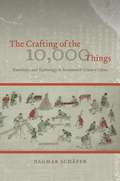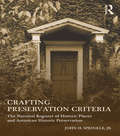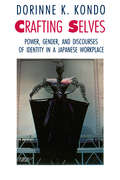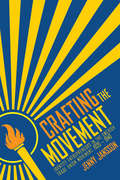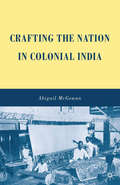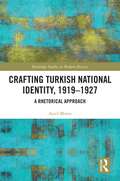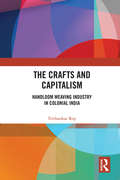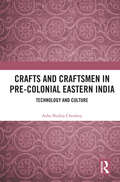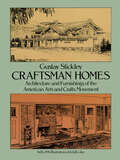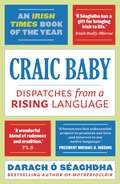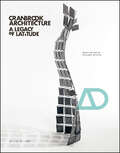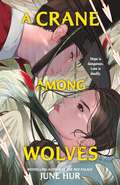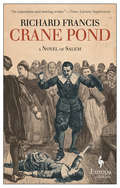- Table View
- List View
The Crafting of the 10,000 Things: Knowledge and Technology in Seventeenth-Century China
by Dagmar SchäferThe last decades of the Ming dynasty, though plagued by chaos and destruction, saw a significant increase of publications that examined advances in knowledge and technology. Among the numerous guides and reference books that appeared during this period was a series of texts by Song Yingxing (1587–1666?), a minor local official living in southern China. His Tiangong kaiwu, the longest and most prominent of these works, documents the extraction and processing of raw materials and the manufacture of goods essential to everyday life, from yeast and wine to paper and ink to boats, carts, and firearms. In The Crafting of the 10,000 Things, Dagmar Schäfer probes this fascinating text and the legacy of its author to shed new light on the development of scientific thinking in China, the purpose of technical writing, and its role in and effects on Chinese history. Meticulously unfolding the layers of Song’s personal and cultural life, Schäfer chronicles the factors that motivated Song to transform practical knowledge into written culture. She then examines how Song gained, assessed, and ultimately presented knowledge, and in doing so articulates this era’s approaches to rationality, truth, and belief in the study of nature and culture alike. Finally, Schäfer places Song’s efforts in conjunction with the work of other Chinese philosophers and writers, before, during, and after his time, and argues that these writings demonstrate collectively a uniquely Chinese way of authorizing technology as a legitimate field of scholarly concern and philosophical knowledge. Offering an overview of a thousand years of scholarship, The Crafting of the 10,000 Things explains the role of technology and crafts in a culture that had an outstandingly successful tradition in this field and was a crucial influence on the technical development of Europe on the eve of the Industrial Revolution.
The Crafting of the 10,000 Things: Knowledge and Technology in Seventeenth-Century China
by Dagmar SchäferThe last decades of the Ming dynasty, though plagued by chaos and destruction, saw a significant increase of publications that examined advances in knowledge and technology. Among the numerous guides and reference books that appeared during this period was a series of texts by Song Yingxing (1587–1666?), a minor local official living in southern China. His Tiangong kaiwu, the longest and most prominent of these works, documents the extraction and processing of raw materials and the manufacture of goods essential to everyday life, from yeast and wine to paper and ink to boats, carts, and firearms. In The Crafting of the 10,000 Things, Dagmar Schäfer probes this fascinating text and the legacy of its author to shed new light on the development of scientific thinking in China, the purpose of technical writing, and its role in and effects on Chinese history. Meticulously unfolding the layers of Song’s personal and cultural life, Schäfer chronicles the factors that motivated Song to transform practical knowledge into written culture. She then examines how Song gained, assessed, and ultimately presented knowledge, and in doing so articulates this era’s approaches to rationality, truth, and belief in the study of nature and culture alike. Finally, Schäfer places Song’s efforts in conjunction with the work of other Chinese philosophers and writers, before, during, and after his time, and argues that these writings demonstrate collectively a uniquely Chinese way of authorizing technology as a legitimate field of scholarly concern and philosophical knowledge. Offering an overview of a thousand years of scholarship, The Crafting of the 10,000 Things explains the role of technology and crafts in a culture that had an outstandingly successful tradition in this field and was a crucial influence on the technical development of Europe on the eve of the Industrial Revolution.
The Crafting of the 10,000 Things: Knowledge and Technology in Seventeenth-Century China
by Dagmar SchäferThe last decades of the Ming dynasty, though plagued by chaos and destruction, saw a significant increase of publications that examined advances in knowledge and technology. Among the numerous guides and reference books that appeared during this period was a series of texts by Song Yingxing (1587–1666?), a minor local official living in southern China. His Tiangong kaiwu, the longest and most prominent of these works, documents the extraction and processing of raw materials and the manufacture of goods essential to everyday life, from yeast and wine to paper and ink to boats, carts, and firearms. In The Crafting of the 10,000 Things, Dagmar Schäfer probes this fascinating text and the legacy of its author to shed new light on the development of scientific thinking in China, the purpose of technical writing, and its role in and effects on Chinese history. Meticulously unfolding the layers of Song’s personal and cultural life, Schäfer chronicles the factors that motivated Song to transform practical knowledge into written culture. She then examines how Song gained, assessed, and ultimately presented knowledge, and in doing so articulates this era’s approaches to rationality, truth, and belief in the study of nature and culture alike. Finally, Schäfer places Song’s efforts in conjunction with the work of other Chinese philosophers and writers, before, during, and after his time, and argues that these writings demonstrate collectively a uniquely Chinese way of authorizing technology as a legitimate field of scholarly concern and philosophical knowledge. Offering an overview of a thousand years of scholarship, The Crafting of the 10,000 Things explains the role of technology and crafts in a culture that had an outstandingly successful tradition in this field and was a crucial influence on the technical development of Europe on the eve of the Industrial Revolution.
The Crafting of the 10,000 Things: Knowledge and Technology in Seventeenth-Century China
by Dagmar SchäferThe last decades of the Ming dynasty, though plagued by chaos and destruction, saw a significant increase of publications that examined advances in knowledge and technology. Among the numerous guides and reference books that appeared during this period was a series of texts by Song Yingxing (1587–1666?), a minor local official living in southern China. His Tiangong kaiwu, the longest and most prominent of these works, documents the extraction and processing of raw materials and the manufacture of goods essential to everyday life, from yeast and wine to paper and ink to boats, carts, and firearms. In The Crafting of the 10,000 Things, Dagmar Schäfer probes this fascinating text and the legacy of its author to shed new light on the development of scientific thinking in China, the purpose of technical writing, and its role in and effects on Chinese history. Meticulously unfolding the layers of Song’s personal and cultural life, Schäfer chronicles the factors that motivated Song to transform practical knowledge into written culture. She then examines how Song gained, assessed, and ultimately presented knowledge, and in doing so articulates this era’s approaches to rationality, truth, and belief in the study of nature and culture alike. Finally, Schäfer places Song’s efforts in conjunction with the work of other Chinese philosophers and writers, before, during, and after his time, and argues that these writings demonstrate collectively a uniquely Chinese way of authorizing technology as a legitimate field of scholarly concern and philosophical knowledge. Offering an overview of a thousand years of scholarship, The Crafting of the 10,000 Things explains the role of technology and crafts in a culture that had an outstandingly successful tradition in this field and was a crucial influence on the technical development of Europe on the eve of the Industrial Revolution.
The Crafting of the 10,000 Things: Knowledge and Technology in Seventeenth-Century China
by Dagmar SchäferThe last decades of the Ming dynasty, though plagued by chaos and destruction, saw a significant increase of publications that examined advances in knowledge and technology. Among the numerous guides and reference books that appeared during this period was a series of texts by Song Yingxing (1587–1666?), a minor local official living in southern China. His Tiangong kaiwu, the longest and most prominent of these works, documents the extraction and processing of raw materials and the manufacture of goods essential to everyday life, from yeast and wine to paper and ink to boats, carts, and firearms. In The Crafting of the 10,000 Things, Dagmar Schäfer probes this fascinating text and the legacy of its author to shed new light on the development of scientific thinking in China, the purpose of technical writing, and its role in and effects on Chinese history. Meticulously unfolding the layers of Song’s personal and cultural life, Schäfer chronicles the factors that motivated Song to transform practical knowledge into written culture. She then examines how Song gained, assessed, and ultimately presented knowledge, and in doing so articulates this era’s approaches to rationality, truth, and belief in the study of nature and culture alike. Finally, Schäfer places Song’s efforts in conjunction with the work of other Chinese philosophers and writers, before, during, and after his time, and argues that these writings demonstrate collectively a uniquely Chinese way of authorizing technology as a legitimate field of scholarly concern and philosophical knowledge. Offering an overview of a thousand years of scholarship, The Crafting of the 10,000 Things explains the role of technology and crafts in a culture that had an outstandingly successful tradition in this field and was a crucial influence on the technical development of Europe on the eve of the Industrial Revolution.
Crafting Preservation Criteria: The National Register of Historic Places and American Historic Preservation
by John H. Sprinkle, Jr.In 1966, American historic preservation was transformed by the passage of the National Historic Preservation Act, which created a National Register of Historic Places. Now comprising more than 1.4 million historic properties across the country, the National Register is the official federal list of places in the United States thought to be worthy of preservation. One of the fundamental principles of the National Register is that every property is evaluated according to a standard set of criteria that provide the framework for understanding why a property is significant in American history. The origins of these criteria are important because they provide the threshold for consideration by a broad range of federal preservation programs, from planning for continued adaptive use, to eligibility for grants, and inclusion in heritage tourism and educational programs. Crafting Preservation Criteria sets out these preservation criteria for students, explaining how they got added to the equation, and elucidating the test cases that allowed for their use. From artworks to churches, from 'the fifty year rule' to 'the historic scene', students will learn how places have been historically evaluated to be placed on the National Register, and how the criteria evolved over time.
Crafting Preservation Criteria: The National Register of Historic Places and American Historic Preservation
by John H. Sprinkle, Jr.In 1966, American historic preservation was transformed by the passage of the National Historic Preservation Act, which created a National Register of Historic Places. Now comprising more than 1.4 million historic properties across the country, the National Register is the official federal list of places in the United States thought to be worthy of preservation. One of the fundamental principles of the National Register is that every property is evaluated according to a standard set of criteria that provide the framework for understanding why a property is significant in American history. The origins of these criteria are important because they provide the threshold for consideration by a broad range of federal preservation programs, from planning for continued adaptive use, to eligibility for grants, and inclusion in heritage tourism and educational programs. Crafting Preservation Criteria sets out these preservation criteria for students, explaining how they got added to the equation, and elucidating the test cases that allowed for their use. From artworks to churches, from 'the fifty year rule' to 'the historic scene', students will learn how places have been historically evaluated to be placed on the National Register, and how the criteria evolved over time.
Crafting Selves: Power, Gender, and Discourses of Identity in a Japanese Workplace
by Dorinne K. Kondo"The ethnography of Japan is currently being reshaped by a new generation of Japanologists, and the present work certainly deserves a place in this body of literature. . . . The combination of utility with beauty makes Kondo's book required reading, for those with an interest not only in Japan but also in reflexive anthropology, women's studies, field methods, the anthropology of work, social psychology, Asian Americans, and even modern literature."—Paul H. Noguchi, American Anthropologist "Kondo's work is significant because she goes beyond disharmony, insisting on complexity. Kondo shows that inequalities are not simply oppressive-they are meaningful ways to establish identities."—Nancy Rosenberger, Journal of Asian Studies
Crafting Selves: Power, Gender, and Discourses of Identity in a Japanese Workplace
by Dorinne K. Kondo"The ethnography of Japan is currently being reshaped by a new generation of Japanologists, and the present work certainly deserves a place in this body of literature. . . . The combination of utility with beauty makes Kondo's book required reading, for those with an interest not only in Japan but also in reflexive anthropology, women's studies, field methods, the anthropology of work, social psychology, Asian Americans, and even modern literature."—Paul H. Noguchi, American Anthropologist "Kondo's work is significant because she goes beyond disharmony, insisting on complexity. Kondo shows that inequalities are not simply oppressive-they are meaningful ways to establish identities."—Nancy Rosenberger, Journal of Asian Studies
Crafting Selves: Power, Gender, and Discourses of Identity in a Japanese Workplace
by Dorinne K. Kondo"The ethnography of Japan is currently being reshaped by a new generation of Japanologists, and the present work certainly deserves a place in this body of literature. . . . The combination of utility with beauty makes Kondo's book required reading, for those with an interest not only in Japan but also in reflexive anthropology, women's studies, field methods, the anthropology of work, social psychology, Asian Americans, and even modern literature."—Paul H. Noguchi, American Anthropologist "Kondo's work is significant because she goes beyond disharmony, insisting on complexity. Kondo shows that inequalities are not simply oppressive-they are meaningful ways to establish identities."—Nancy Rosenberger, Journal of Asian Studies
Crafting Selves: Power, Gender, and Discourses of Identity in a Japanese Workplace
by Dorinne K. Kondo"The ethnography of Japan is currently being reshaped by a new generation of Japanologists, and the present work certainly deserves a place in this body of literature. . . . The combination of utility with beauty makes Kondo's book required reading, for those with an interest not only in Japan but also in reflexive anthropology, women's studies, field methods, the anthropology of work, social psychology, Asian Americans, and even modern literature."—Paul H. Noguchi, American Anthropologist "Kondo's work is significant because she goes beyond disharmony, insisting on complexity. Kondo shows that inequalities are not simply oppressive-they are meaningful ways to establish identities."—Nancy Rosenberger, Journal of Asian Studies
Crafting the Movement: Identity Entrepreneurs in the Swedish Trade Union Movement, 1920–1940
by Jenny JanssonCrafting the Movement presents an explanation of why the Swedish working class so unanimously adopted reformism during the interwar period. Jenny Jansson discusses the precarious time for the labor movement after the Russian Revolution in 1917 that sparked a trend towards radicalization among labor organizations and communist organizations throughout Europe and caused an identity crisis in class organizations. She reveals that the leadership of the Trade Union Confederation (LO) was well aware of the identity problems that the left-wing factions had created for the reformist unions.Crafting the Movement explains how this led labor movement leaders towards a re-formulation of the notion of the worker by constructing an organizational identity that downplayed class struggle and embraced discipline, peaceful solutions to labor market problems, and cooperation with the employers. As Jansson shows, study activities arranged by the Workers' Educational Association became the main tool of the Trade Union Confederation's identity policy in the 1920s and 1930s and its successful outcome paved the way for the well-known "Swedish Model."Thanks to generous funding from Uppsala University, the ebook editions of this book are available as Open Access volumes from Cornell Open (cornellopen.org) and other Open Access repositories.
Crafting the Nation in Colonial India
by A. McGowanDrawing on a wide range of archival evidence, Abigail McGowan argues that crafts seized the political imagination in western India because they provided a means of debating the present and future of the country.
Crafting Turkish National Identity, 1919-1927: A Rhetorical Approach (Routledge Studies in Modern History)
by Aysel MorinExamining Mustafa Kemal Atatürk’s Büyük Nutuk (The Great Public Address), this book identifies the five founding political myths of Turkey: the First Duty, the Internal Enemy, the Encirclement, the Ancestor, and Modernity. Offering a comprehensive rhetorical analysis of Nutuk in its entirety, the book reveals how Atatürk crafted these myths, traces their discursive roots back to the Orkhon Inscriptions, epic tales, and ancient stories of Turkish culture, and critiques their long-term effects on Turkish political culture. In so doing, it advances the argument that these myths have become permanent fixtures of Turkish political discourse since the establishment of Turkey and have been used by both supporters and detractors of Atatürk. Providing examples of how past and present leaders, including Recep Tayyip Erdoğan, a vocal critic of Atatürk, have deployed these myths in their discourses, the book offers an entirely new way to read and understand Turkish political culture and contributes to the heated debate on Kemalism by responding to the need to go back to the original sources – his own speeches and statements – to understand him. Contributing to emerging discourse-based approaches, this book is ideal for scholars and students of Turkish Studies, History, Nationalism Studies, Political Science, Rhetorical Studies, and International Studies.
Crafting Turkish National Identity, 1919-1927: A Rhetorical Approach (Routledge Studies in Modern History)
by Aysel MorinExamining Mustafa Kemal Atatürk’s Büyük Nutuk (The Great Public Address), this book identifies the five founding political myths of Turkey: the First Duty, the Internal Enemy, the Encirclement, the Ancestor, and Modernity. Offering a comprehensive rhetorical analysis of Nutuk in its entirety, the book reveals how Atatürk crafted these myths, traces their discursive roots back to the Orkhon Inscriptions, epic tales, and ancient stories of Turkish culture, and critiques their long-term effects on Turkish political culture. In so doing, it advances the argument that these myths have become permanent fixtures of Turkish political discourse since the establishment of Turkey and have been used by both supporters and detractors of Atatürk. Providing examples of how past and present leaders, including Recep Tayyip Erdoğan, a vocal critic of Atatürk, have deployed these myths in their discourses, the book offers an entirely new way to read and understand Turkish political culture and contributes to the heated debate on Kemalism by responding to the need to go back to the original sources – his own speeches and statements – to understand him. Contributing to emerging discourse-based approaches, this book is ideal for scholars and students of Turkish Studies, History, Nationalism Studies, Political Science, Rhetorical Studies, and International Studies.
The Crafts and Capitalism: Handloom Weaving Industry in Colonial India
by Tirthankar RoyThis book presents a comprehensive history of handloom weaving industry in India to challenge and revise the view that competition from machine-produced textiles destroyed the country’s handicrafts as claimed by historians until recently. It shows that skill-intensive handmade textiles survived the competition on a large scale, and that handmade goods and high-quality manual labour played a positive role in the making of modern India. Rich in archival material, The Crafts and Capitalism explores themes such as the historiography of craft technologies; statistical work on nineteenth-century cotton cloth production trends; narratives of merchants, the social leaders, the factory-owners; tools and techniques; and, shift from handloom to power loom. The book argues that changes in the handloom industry were central to the consolidation of new forms of capitalism in India. An important intervention in Indian economic history, this book will be useful to scholars and researchers of Indian history, economic history, colonial history, modern history, political history, labour history and political economy. It will also interest nongovernmental organizations, textile historians, and design specialists.
The Crafts and Capitalism: Handloom Weaving Industry in Colonial India
by Tirthankar RoyThis book presents a comprehensive history of handloom weaving industry in India to challenge and revise the view that competition from machine-produced textiles destroyed the country’s handicrafts as claimed by historians until recently. It shows that skill-intensive handmade textiles survived the competition on a large scale, and that handmade goods and high-quality manual labour played a positive role in the making of modern India. Rich in archival material, The Crafts and Capitalism explores themes such as the historiography of craft technologies; statistical work on nineteenth-century cotton cloth production trends; narratives of merchants, the social leaders, the factory-owners; tools and techniques; and, shift from handloom to power loom. The book argues that changes in the handloom industry were central to the consolidation of new forms of capitalism in India. An important intervention in Indian economic history, this book will be useful to scholars and researchers of Indian history, economic history, colonial history, modern history, political history, labour history and political economy. It will also interest nongovernmental organizations, textile historians, and design specialists.
Crafts and Craftsmen in Pre-colonial Eastern India: Technology and Culture
by Asha Shukla ChoubeyThis book presents a comprehensive socio-cultural history of crafts and crafts persons in pre-colonial Eastern India. It focuses on the technology of crafts as being integral to the traditional lives of the crafts persons and explores their cultural and social world. It offers an in-depth analysis of the complexities of craft technologies in the three sectors of cotton textile, sericulture and silk textile and mining and metallurgy in the regions of Bihar and Jharkhand in Eastern India in the seventeenth and eighteenth centuries. Apart from technology, the book discusses a range of socio-economic themes including craft production systems; marketing and financing patterns; impact of contact with the world market; craft persons’ identities in terms of caste affiliations and group divisions; negotiations for upward caste mobility; contestations and dissent of lower castes; power and social stratification; functioning of caste panchayats; gender division of craft labour; myths, beliefs and religiosity attributed to craft usages; social and ritual traditions; and contemporary craft traditions. Rich in archival and diverse sources, including oral traditions, paintings, and findings from extensive field visits and interactions with crafts persons, this book will be an essential read for scholars and researchers of crafts, medieval Indian history, social history, sociology and social anthropology, economic history, cultural history, science and technology studies, and South Asian studies. It will also interest government and non-governmental organisations, textile historians, craft and design specialists, contemporary craft industrial sector, and museums.
Crafts and Craftsmen in Pre-colonial Eastern India: Technology and Culture
by Asha Shukla ChoubeyThis book presents a comprehensive socio-cultural history of crafts and crafts persons in pre-colonial Eastern India. It focuses on the technology of crafts as being integral to the traditional lives of the crafts persons and explores their cultural and social world. It offers an in-depth analysis of the complexities of craft technologies in the three sectors of cotton textile, sericulture and silk textile and mining and metallurgy in the regions of Bihar and Jharkhand in Eastern India in the seventeenth and eighteenth centuries. Apart from technology, the book discusses a range of socio-economic themes including craft production systems; marketing and financing patterns; impact of contact with the world market; craft persons’ identities in terms of caste affiliations and group divisions; negotiations for upward caste mobility; contestations and dissent of lower castes; power and social stratification; functioning of caste panchayats; gender division of craft labour; myths, beliefs and religiosity attributed to craft usages; social and ritual traditions; and contemporary craft traditions. Rich in archival and diverse sources, including oral traditions, paintings, and findings from extensive field visits and interactions with crafts persons, this book will be an essential read for scholars and researchers of crafts, medieval Indian history, social history, sociology and social anthropology, economic history, cultural history, science and technology studies, and South Asian studies. It will also interest government and non-governmental organisations, textile historians, craft and design specialists, contemporary craft industrial sector, and museums.
Craftsman Bungalows: Designs from the Pacific Northwest (Dover Architecture Ser.)
by Yoho MerrittFrom the late nineteenth century to the early 1920s, the Arts and Crafts Movement spread with great popularity across America. With origins in Britain, the Craftsman style was a reaction against the excesses of the Victorian era. Craftsman bungalows were distinguished by their charming simplicity, cozy style, and storybook appeal. The name was derived from a popular magazine called The Craftsman, published by renowned furniture designer Gustav Stickley who sold plans for these homes designed for "beauty, convenience, and comfort." This fascinating reprint of a rare architectural catalog is filled with photos of actual completed bungalows from the era, built prior to 1919. A mix of Spanish tile, stucco exteriors, wraparound porches, overhanging gables, handcrafted stone, and woodwork added up to many a homeowner's dream. Geared to the climate of the northern and eastern regions, each bungalow is an authentic Craftsman design and features a photo, description, floor plan, and original costs. A fascinating showcase of primary American architecture, Craftsman Bungalows is an indispensable resource for architects, builders, historians, and illustrators.
Craftsman Homes: Architecture and Furnishings of the American Arts and Crafts Movement
by Gustav Stickley296 architectural drawings, floor plans, and photographs illustrate 40 different kinds of "Mission-style" homes from The Craftsman (1901-16), voice of American style of simplicity and organic harmony. Thorough coverage of Craftsman idea in text and picture, now collector's item.
Craic Baby: Dispatches from a Rising Language
by Darach O'SéaghdhaFrom the author of the bestselling Motherfoclóir, Non-fiction Irish Book of the Year. A TLS BOOK OF THE YEAR. What do we talk about when we talk about Irish? When we talk about saving or supporting a language do we mean the musical combination of syllables, or something more profound? How do new words enter a language, and what is the relationship between that strange dialect called Hiberno-English and its parent language? Craic Baby picks up exactly where Motherfoclóir left off and explores the very new and very old parts of the Irish language from a personal perspective. While Motherfoclóir was steeped in memory and a father-son relationship, Craic Baby hinges on the beginnings of a father-daughter relationship, and how watching a child learn to communicate changes how you think about language. Craic Baby will share more Irish words and issues connected to the language, in the same style as Motherfoclóir, but treated with greater confidence and more depth.
Cranbrook Architecture: A Legacy of Latitude (Architectural Design)
by Gretchen WilkinsGuest-edited by Gretchen Wilkins The renowned Cranbrook Academy of Art near Detroit, Michigan, has been described as the epicentre of American Modernism. When it opened in 1932 it combined a stunning Eliel Saarinen-designed campus with a radically open educational philosophy to attract and produce some of the most influential artists, designers and architects in US history, including Charles and Ray Eames, Fumihiko Maki, Florence Knoll and Edmund Bacon. Often compared to other experimental schools such as the Bauhaus, Black Mountain College and Taliesin, Cranbrook’s sustained purpose has been advancing a wide, interdisciplinary latitude and self-directed design research to expand and diversify its approaches to architectural practice. There is a deep and persistent idea that open and experimental acts of making should define pedagogy, and by extension that education should shape practice, not the other way around. Cranbrook’s rigorous defiance of dogma and loose grip on the disciplines enables an educational model that combines the practices of art, design, making and urbanism. In this issue, alumni, faculty and scholars reflect on Cranbrook’s model in light of contemporary and challenging questions in architectural education, practice and the profession. Contributors: Kevin Adkisson, Emily Baker, Peggy Deamer, Pia Ednie-Brown, Ronit Eisenbach, Dan Hoffman, Yu-Chih Hsiao, Peter Lynch, Bill Massie, Hani Rashid, Jesse Reiser, Lois Weinthal, and Tod Williams. Featured architects: Asymptote Architecture, Building Culture PLA, Reiser+Umemoto (RUR), Studio Libeskind, and Tod Williams Billie Tsien.
A Crane Among Wolves: A heart-pounding tale of romance and court politics – for fans of historical K-dramas
by June HurA devastating and pulse-pounding tale that will feel all-too-relevant in today's world, based on a true story from Korean history.Hope is dangerous. Love is deadly. 1506, Joseon. The people suffer under the cruel reign of the tyrant King Yeonsan, powerless to stop him from commandeering their land for his recreational use, banning and burning books, and kidnapping and horrifically abusing women and girls as his personal playthings.Seventeen-year-old Iseul has lived a sheltered, privileged life despite the kingdom's turmoil. When her older sister, Suyeon, becomes the king's latest prey, Iseul leaves the relative safety of her village, traveling through forbidden territory to reach the capital in hopes of stealing her sister back. But she soon discovers the king's power is absolute, and to challenge his rule is to court certain death. Prince Daehyun has lived his whole life in the terrifying shadow of his despicable half-brother, the king. Forced to watch King Yeonsan flaunt his predation through executions and rampant abuse of the common folk, Daehyun aches to find a way to dethrone his half-brother once and for all. When staging a coup, failure is fatal, and he'll need help to pull it off-but there's no way to know who he can trust.When Iseul's and Daehyun's fates collide, their contempt for each other is transcended only by their mutual hate for the king. Armed with Iseul's family connections and Daehyun's royal access, they reluctantly join forces to launch the riskiest gamble the kingdom has ever seen:Save her sister. Free the people. Destroy a tyrant. 'June Hur reigns supreme in making the past come alive.' CHLOE GONG'Gripping and devastating.' ANN LIANG 'There were literally moments in this book where I forgot to breathe.' ELLEN OH
Crane Pond: A Novel of Salem
by Richard FrancisAbsorbing new telling of one of America’s founding stories.The great success last year of Stacy Schiff’s The Witches proves, once again, that abiding interest in the Salem Witch Trials remains high. Richard Francis’s stunning novel Crane Pond is the story of Samuel Sewall, loving father and husband, anti-slavery advocate, defender of Native American rights, and presiding judge at the Salem Witchcraft Trials in 1692, where he sentenced twenty innocent women to death. He was the only judge to later admit his terrible mistake, and ask for forgiveness. At once a searing view of the Trials from the inside out, an empathetic portrait of one of the period’s most tragic and redemptive figures, and an indictment of the malevolent power of religious and political idealism, Crane Pond explores the inner life of a well-meaning man who did evil. It humanizes an unflinching portrait of political hysteria that is as relevant today as it was in the seventeenth century.Richard Francis, Sewall’s most lauded biographer, seamlessly marries rigorous research and astute understanding of a deeply complex character to a compelling dramatic framework sure to enchant readers of quality historical fiction.
